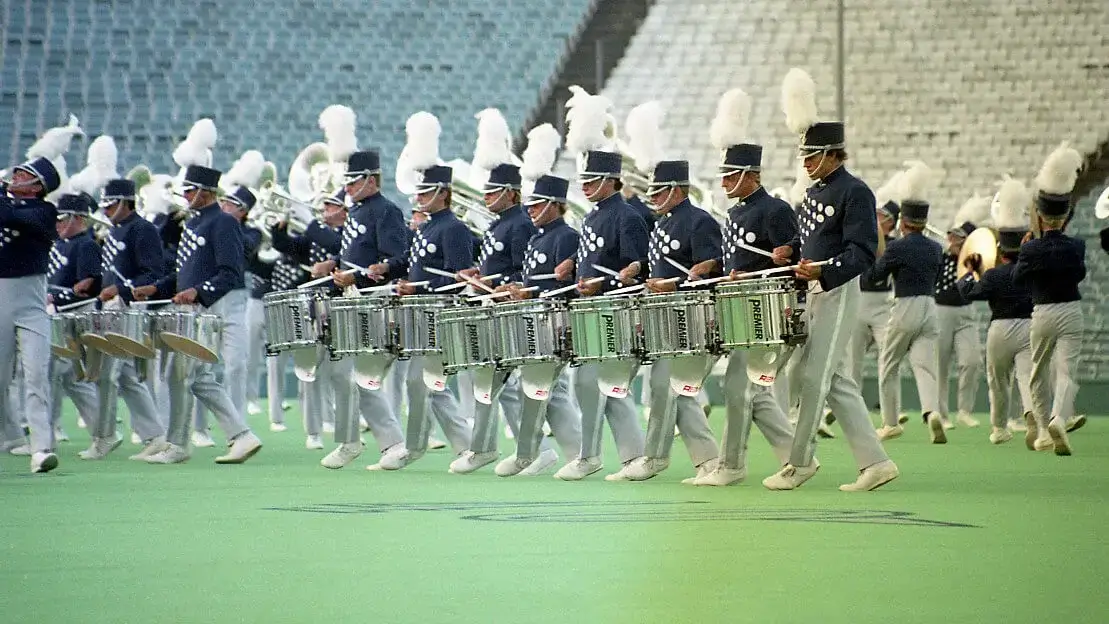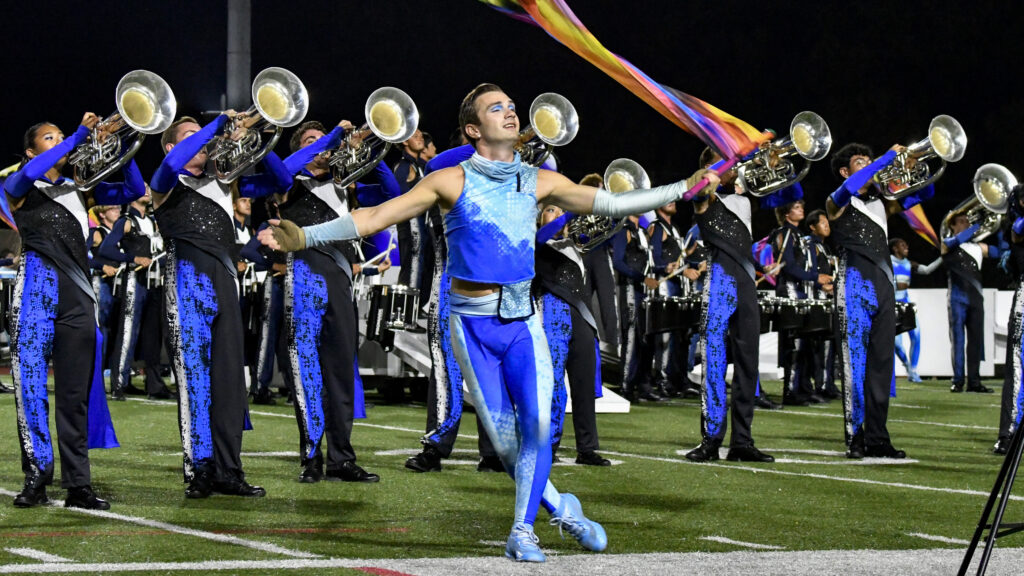In August of 1991, the Drum Corps International World Championships were held at Cotton Bowl Stadium in Dallas, Texas, built on the grounds of the State Fair of Texas.
For the first and only time in DCI history this year, the top three corps in the Finals competition all hailed from the same region and just two states; the Star of Indiana, Cavaliers, and Phantom Regiment.
Also for the first time, the title-winning corps didn’t win any caption awards outright: Champion Star of Indiana tied Cavaliers and Phantom Regiment in Total General Effect, tied Blue Devils in Total Brass, and tied Cavaliers and Santa Clara Vanguard in Total Percussion, winning the title despite placing 3rd in Total Visual.
Three finalist corps from 1990 did not make the Finals, including Velvet Knights, Spirit of Atlanta, and Dutch Boy. It would also be the last year Sky Ryders were to appear as a finalist corps.

1991 also marked the first that the ninth-place Blue Knights appeared among the top-12 corps in the Finals. The corps had been steadily moving up in the rankings over the prior six years, placing 31st in 1985, then 27th, 22nd, 17th, 16th, and 13th in 1990.
It was also the first year the corps premiered its uniforms with the triangular block of 21 large dots, designed by corps alum David Lacy and inspired by the ceremonial uniforms of the U.S. Air Force Academy near Colorado Springs. Although the dots are no longer prominently featured on the corps’ uniforms, they remain the corps’ logo, now in a configuration of 10 dots.
Blue Knights’ production incorporated three overtures by American symphonic composers, Ron Nelson and Aaron Copland, each written to express the grandeur of an outdoor environment. The first selection was Nelson’s “Savannah River Holiday,” originally composed in 1953 for orchestra and later arranged by Nelson for concert band. It’s said the reason he made the piece available for band was due to the difficulty of getting orchestras to play new works, while simultaneously, band directors were clamoring for anything new to offer their students and audiences. The work, comprised of contrasting energy and calmness, was inspired by the character of the river that forms most of the border between Georgia and South Carolina.

Reflecting the bright and brash vibrancy of the music, 16 members of the color guard opened the show with solid yellow flags, while nine spun solid red flags. The two colors remained segregated from each other, with the entire guard moving to yellow flags near the end of the opener for the final brash conclusion.
Aaron Copland wrote “Outdoor Overture” in 1938 on request of the orchestra director at New York’s High School of Music and Art, who asked for a piece to kick off the school’s focus on “American music for American youth.” Copland hadn’t named the piece when he gave it in piano form for the director; they both settled on the title when the director commented the piece had an open-air sensibility. It didn’t take long for the overture to make its way into the repertoires of amateur and professional orchestras. Modernist composer Elliot Carter, writing a commentary in “Modern Music” magazine, wrote that the overture contained some of Copland’s “finest and most personal music … Copland in his prophetic vein which runs through all his works.”
Indeed, as in much of Copland’s music, the wide-open chords of the corps’ introduction to the piece seemed to hang in mid-air, projecting a sense of the vast sweeping element of nature. The color guard members unveiled a series of pastel hand-painted flags in floral prints. This flag design would become a corps trademark for almost two decades. For a percussion break, marching bells and xylophone were utilized within the drum line, briefly adding a different tonal effect.

The final overture in the show was Ron Nelson’s “Aspen Jubilee,” written in 1984 and incorporating an extended soprano vocal solo. Nelson, who spent 13 summers at the Aspen Music Festival, wrote, “I was thinking of the stupendous beauty of the Rockies in general, of blinding sunlight on snow-covered peaks; of the frontier spirit of old Aspen with its brash, funny dynamism, its corny ragtag Fourth of July parades and fireworks displays. I was also thinking about indescribably beautiful nights under star-filled skies.”
An elegiac melody, sung by a soprano voice in the original version, was transferred to a mellophone soloist. Brass players and percussionists framed the guard members, who expressively performed a tender ballet-like dance sans equipment. This was the opening section in which Nelson above expressed the “stupendous beauty of the Rockies,” soaring across the field not unlike the view of the Rockies quietly dominating the visual background of everything on the Colorado plains.
During the final two minutes of the production, the color guard members returned to bright yellow swing flags that also doubled as shawls, before returning to solid red flags similar to those seen earlier, but with split ends and more sparkle. The musical selection, which was inspired by the elevated grandeur of Colorado’s most dramatic and inspiring scenery, was appropriate for the conclusion of the first finalist program performed by a Colorado corps.
1991 Overview

Michael Boo was a member of the Cavaliers from 1975-1977. He wrote about the drum corps activity for more than 35 years while serving as a staff writer for various Drum Corps International projects. During his lifetime Boo wrote for numerous other publications including an honors-winning book on the history of figure skating. He also was an accomplished composer. Boo passed away in November of 2020





